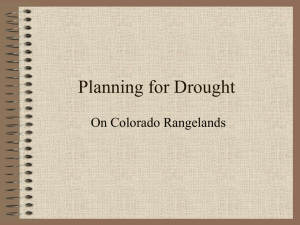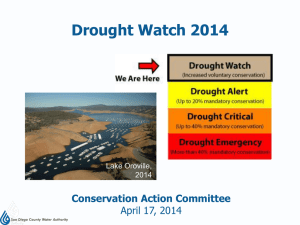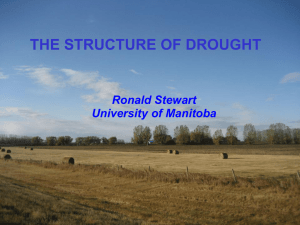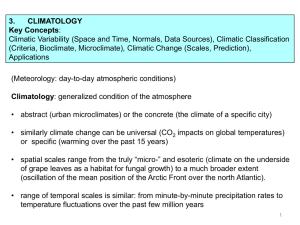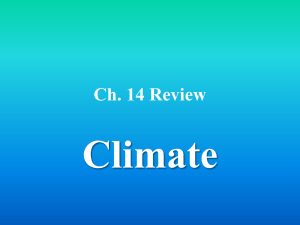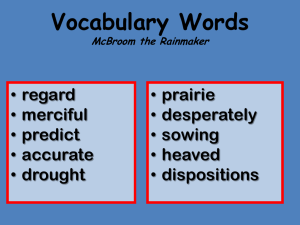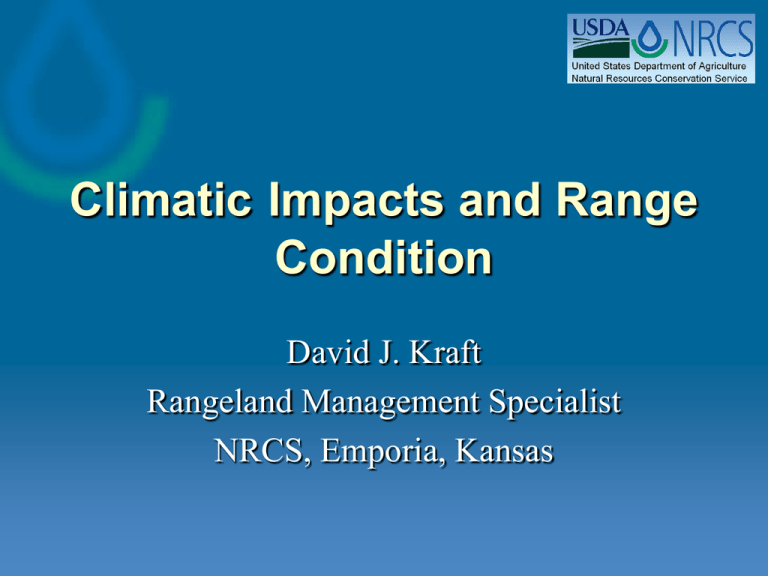
Climatic Impacts and Range
Condition
David J. Kraft
Rangeland Management Specialist
NRCS, Emporia, Kansas
Climatic Impacts and Range
Condition
Identifying
the problems or understanding
drought symptoms.
Goals for today!
Identifying resource concerns
Understanding the impacts
Formulating an approach
Measuring the success or accomplishment
Climatic Impacts and Range
Condition
So
what are some of the reasons for
changes in plant communities?
Climatic conditions (out of our control)
Management (within our control)
Combination of the two!
Climatic Impacts and Range
Condition
Adaptive
Management Approach
Optimal decision making in the face of
uncertainty, with an aim to reducing
uncertainty over time (Wikipedia)
Climatic Impacts and Range
Condition
Drought
is a major factor in range
management!
In any given year, rangeland vegetation is
either in the recovery phase, under the direct
influence of drought, or by the producer’s
management, preparing for drought
Management strategies must provide plants
with opportunities to maintain or improve vigor
Climatic Impacts and Range
Condition
Drought
is generally defined as a
prolonged period of time during which
precipitation is less than 75 percent of
average for a given year, or poor
distribution of precipitation in a single year
or less than average precipitation in
successive years
Climatic Impacts and Range
Condition
History
and Impacts of past droughts:
Dramatic shifts in species composition and
productivity of native grasslands were
documented in the Great Plains during and
following the major drought of the 1930’s
Climatic Impacts and Range
Condition
History
and Impacts of past droughts:
Finding: The combination of drought and
heavy grazing can cause severe reductions in
forage production and plant vigor.
Climatic Impacts and Range
Condition
As
plant communities change, the surface
or plant cover also changes.
Good
grazing management is vital to
maximize the effectiveness of
precipitation.
Climatic Impacts and Range
Condition
Practices
which increase plant cover or
plant vigor lead to an increase in the
amount of precipitation that enters the soil
Climatic Impacts and Range
Condition
When
plant vigor improves, root systems
become more extensive and provide
surface openings for water movement into
the soil profile
Climatic Impacts and Range
Condition
Plant
litter and standing plants reduce
evaporation losses by moderating
extremes in soil surface temperatures and
the impact of drying winds
Climatic Impacts and Range
Condition
Negative
impacts of Drought and
Management:
Lower range conditions intensify drought
effects.
Decreased diversity in the native plant
community reflects more severe drought
impacts. (Lower range condition-more severe
impacts)
Climatic Impacts and Range
Condition
Negative
Impacts cont:
Recovery time is increased in rangeland
where range condition or vigor is lower going
into drought periods
Climatic Impacts and Range
Condition
Negative
Impacts cont:
Improvement of rangeland condition and vigor
should be practiced or targeted in years not
identified as drought years, leading to quicker
recovery of plant communities coming out of
drought periods
Climatic Impacts and Range
Condition
Drought
Plan? Do we need one? What
does it contain?
A drought plan should:
protect vegetation and plant communities during a
drought
hasten vegetation recovery after drought
be specific to your operation
minimize financial hardship
Climatic Impacts and Range
Condition
Drought
Plan cont:
Drought plans identify action to be taken at
the first sign of drought as well as with
continued indications of moisture and forage
shortages
Stocking rate adjustments need to be specific
in terms of how many and how long
Climatic Impacts and Range
Condition
Drought
Plan cont:
Actions should be based upon seasonal
check points and indicators
Ex. (monthly monitoring, moisture to begin the
growing season, quickness of green-up of
desirable species, production available based
upon expected yields throughout the growing
season, and carryover or accumulated forage)
Climatic Impacts and Range
Condition
Contingency
East
April 1
June 15
July 15
Aug 15
Sept – Nov
Plan Trigger Dates
Central
Sept 15 – Nov
April 1
June 15
July 15
Aug 15
West
24 Month
June 1
July 1
Aug 1
Climatic Impacts and Range
Condition
Stocking
rate rules of thumb:
Cattle require approximately 3% of their body
weight in pounds of forage each day
1000 pound cow = 30 pounds of air dry forage
At a minimum 900 pounds per month
Climatic Impacts and Range
Condition
Stocking
Rate Breakdown:
If your rangeland produces 4000 pounds/acre
Approximately 1000 pounds is available to be
grazed
Meaning it takes approximately one
acre/month to support an 1100 pound cow if
your rangeland averages 4000 pounds of
production
Climatic Impacts and Range
Condition
Stocking
Rate Breakdown:
Depending upon the production potential of
your rangeland, you will need more or less
acres to support your livestock
Climatic Impacts and Range
Condition
Stocking
Rate Breakdown:
What do I need to know?
What does my rangeland/grazingland produce in
pounds of air dry forage?
What do my livestock actually weigh?
What is their true demand?
How do I compensate for cows with calves?
Climatic Impacts and Range
Condition
Stocking
Rate Breakdown:
Are there years when production is greater
than normal as well as less than normal?
What are the impacts to the livestock as well
as the forage or plant community during
drought?
IT DEPENDS! – ON YOU!
Climatic Impacts and Range
Condition
100%
90%
Percent of Average
rainfall between March
and May
Stocking Rate Reduction
80%
70%
60%
50%
40%
30%
20%
10%
0%
1
2
3
4
Climatic Impacts and Range
Condition
Reduction in Stocking
Rate
Stocking Rate Reductions on Sandy Soils
60%
50%
Good Condition Plant
Community
40%
30%
Poor to Fair Condition
Plant Community
20%
10%
0%
48" 42" 36" 30" 24" 18" 12"
Inches of Moist Soil
6"
Climatic Impacts and Range
Condition
Region
Northwest
West Central
Southwest
North Central
Central
South Central
Northeast
East Central
Southeast
STATE
Total
16.36
13.38
8.51
21.81
16.71
12.18
24.36
19.77
24.1
16.95
Precipitation - 2011 through November
Dep.
% Normal
-3.43
83
-5.87
70
-10.36
45
-4.37
83
-11.06
60
-15.15
45
-9.56
72
-15.58
56
-12.7
65
-9.79
63
Climatic Impacts and Range
Condition
90
80
70
Rainfall from
January thru
November
2011
60
50
40
Normal Rainfall (inches)
Actual Rainfall (inches)
30
20
10
0
Percent of Normal
Climatic Impacts and Range
Condition
Stocking
Rate Breakdown:
Typically animal performance does not suffer
in drought conditions until animal intake is
reduced significantly (forage quality remains
high)
Climatic Impacts and Range
Condition
Stocking
Rate Breakdown:
Remember, heavy continuous grazing which
alters the plant community and changes the
surface of the soil, makes possible:
harsher conditions and drought impacts
more difficult and lengthy recovery periods
potential financial hardship due to extended
forage reduction
Climatic Impacts and Range
Condition
Things
to remember:
The healthier a plant community enters a
drought and the more carefully a plant
community is managed during a drought, the
quicker and healthier a plant community will
respond coming out of a drought
Climatic Impacts and Range
Condition
Examples
of Management Style Changes
Grazing systems which focus on rest
Flexibility in herd management
Early weaning
Later calving season
Minimizing feed costs or inputs
Limit feeding hay
Climatic Impacts and Range
Condition
Questions
Nondiscrimination
Statement
The U.S. Department of Agriculture (USDA) prohibits discrimination in all
its programs and activities on the basis of race, color, national origin,
sex, religion, age, disability, political beliefs, sexual orientation, or
marital or family status. (Not all prohibited bases apply to all programs.)
Persons with disabilities who require alternative means for
communication of program information (Braille, large print, audiotape,
etc.) should contact USDA's TARGET Center at (202) 720-2600 (voice and
TDD).
To file a complaint of discrimination, write USDA, Director, Office of Civil
Rights, Room 326W, Whitten Building, 1400 Independence Avenue, SW,
Washington, DC 20250-9410, or call (202) 720-5964 (voice and TDD).
USDA is an equal opportunity provider and employer.

